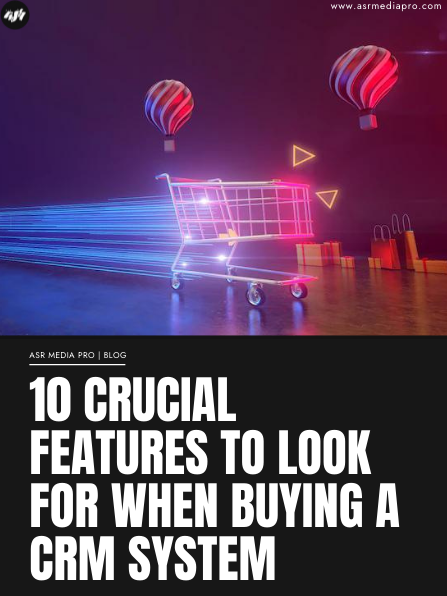
10 Crucial Features to Look for When Buying a CRM System
10 Crucial Features to Look for When Buying a CRM System As you might expect, leading CRM solutions provide a vast array of features, from
Retail presents a slew of opportunities for augmented reality, particularly in the ecommerce space. As much as people have grown accustomed to the concept of ecommerce, there are still some purchases for which additional contextual information is required. This can be a hindrance to online sales of certain product categories.
That is why DTC furniture retailer Burrow developed an augmented reality app that enables shoppers to customise and place 3D models of Burrow sofas in their own living rooms.
Virtual reality is fully immersive, whereas augmented reality augments the real world.
Simply put, augmented reality augments an already-existing world that you will continue to perceive to some extent. On the other hand, virtual reality — such as Facebook’s Oculus Quest — is an immersive experience that immerses you in a world entirely created by humans. Typically, you are unable to see and are not intended to experience the real world.
Consider Pokemon Go, one of the most well-known augmented reality applications. Users would play the game as they walked down the street, looking at the real world through their phone’s camera, which superimposed digital characters in specific locations.
Augmented reality is more mobile than virtual reality, which requires specialised equipment.
You’ll need to wear a headset and, possibly, hold controllers in your hands to experience virtual reality. Additionally, you must ensure that your physical environment is secure against — well, you. (Avoid being the person who punches their television screen while boxing in virtual reality!)
By contrast, augmented reality typically requires only a smartphone or, in some cases, augmented reality glasses. Because you will be fully aware of your surroundings, you will not be required to clear the room in order to enjoy the experience.
More people have the ability to experience augmented reality than virtual reality.
Finally, AR is more accessible because it requires less equipment and fewer safety precautions. If you create a virtual reality application, the number of people who have the necessary equipment to experience it will be far fewer than the world’s 3 billion smartphone users today!
There are several distinct types of augmented reality technology, each of which provides slightly different capabilities. Consider the following general overview of the most common types of augmented reality applications:
AR based on markers.
Marker-based augmented reality, also known as image recognition or recognition-based augmented reality, detects an object in front of the camera and displays information about it on the screen. When an AR application on a device detects that marker, the app replaces it on the screen with a 3D representation of the corresponding object. The user can then view the object in greater detail and from a variety of angles.
AR without a marker.
Markerless augmented reality does not require a specific object in the real world to trigger it. Rather than that, the user can position a virtual object wherever they please. After that, you can rotate and move the object.
Augmented reality that is location-based.
Location-based augmented reality is a subset of markerless augmented reality that makes use of geographic location to display digital content at specific locations. Pokemon Go is an example of a location-based augmented reality application.
Projection-based augmented reality.
Projection-based augmented reality involves projecting synthetic light onto physical surfaces and allowing users to interact with it in some cases. Typical examples include the holograms that we’ve all seen in science fiction films such as Star Wars.
The adoption of augmented reality technology is accelerating, and advertisers — whether in retail or elsewhere — are taking notice. Consider the following statistics to demonstrate this:
AR enables ecommerce customers to preview products and services in their own environment and at their leisure prior to making a purchase. By utilising augmented reality, your customers can preview products and are more likely to make the correct selection the first time.
Solutions that can be tried on virtually.
“It looked absolutely stunning on the mannequin.” -Everyone, at least once, after trying on a new piece of clothing for the first time and discovering that it does not fit properly.
Fear of that outcome has been shown to reduce conversion rates. Shoppers want to be completely certain of what they’re purchasing and take every precaution to ensure it’s exactly what they want. And if they do decide to purchase and it does not work out, your return rates will increase.
AR enables online shoppers to comprehend what they’re purchasing and how the products will function for them. This technique can be used on clothing, makeup, accessories, and even eyeglasses.
Placement preview.
What will the actual appearance of that couch be in your living room? How large will the television screen be when it is mounted on your wall? Even when you’re in the store and looking at the physical item, it can be difficult to tell — let alone when looking at it on a small computer or mobile screen.
Customers get a real-time preview of what a product will look like when it is placed in their own environment.
Burrow, a DTC furniture brand, utilises augmented reality to assist customers in visualising how their couches will fit in their living rooms. Burrow’s Burrow at Home app leverages ARKit to seamlessly integrate true-to-scale 3D models of Burrow’s couches into photographs taken on customers’ iPhones and iPads.
User manuals that are interactive.
If you’re selling a product that requires some learning before it becomes intuitive for new customers to use, an interactive user manual could be an excellent augmented reality application to assist users in better understanding how your product works.
An interactive user manual reacts to user actions, providing on-page contextual assistance when utilising software, a website, or an application. Numerous augmented reality user manual apps scan the product and indicate the buttons in the real world using graphical arrows and text-based animations.
Filters for social media.
If you’ve recently used Instagram Stories or Snapchat, you may have encountered an augmented reality filter. Initially used for amusement, these filters have seen an increase in the number of brands jumping on the augmented reality bandwagon via social media filters.
Boost customer retention.
Because augmented reality is inherently interactive, it’s easy for customers to become enamoured with your site. Additionally, the longer they stay on your ecommerce website, the greater the likelihood they will make a purchase! Even if they do not make a purchase during their visit, their increased engagement indicates that they have developed a relationship with your brand and product and have most likely created a memory, making them more likely to remember you in the future.
Expand your customer base.
In a noisy world, you’ll need to create a buzz to attract people’s attention. Creating an engaging augmented reality campaign is one way to accomplish this.
Minimize returns.
With augmented reality, you can provide customers with significantly more information about a product than you could with a static image or even a video. Along with 3D views, you can demonstrate what a product would look like in a consumer’s space, reducing the likelihood that they will receive the product and discover it does not look as expected.
If you’ve decided to implement augmented reality in your business, here are some preliminary steps.
Defining your business objectives is critical.
What are your objectives? And, more importantly, how does it benefit your customers? Make certain you do not stop after answering the first question, as the second question has the potential to elevate your augmented reality application to greatness. You must first determine precisely what you want the customer experience to accomplish.
Prior to diving into the technical aspects of your augmented reality application, define your vision and objectives. Once you’ve determined your destination, it’ll be easier to select the techniques and technologies necessary to get there.
Determine which augmented reality tools you wish to use.
Once you’ve determined what you’re going to create, you can begin identifying the tools you’ll need. Consider the following points:
If your budget is limited, you may want to choose an augmented reality platform that offers a free licence. Numerous augmented reality solutions are available with both free and commercial licences. Bear in mind, however, that the free version will be less robust than the full software.
Supported devices: Whether you intend to run your augmented reality application on mobile devices, laptops, or augmented reality glasses, ensure that the tool you use is capable of supporting the hardware required for your application.
Supported operating systems: If you intend to develop apps for multiple operating systems, ensure that the platform you choose supports each operating system.
Capabilities: Thoroughly evaluate each platform to determine if it possesses the specific features you require. For example, not all platforms support geolocation, which means that if you’re planning to create a location-based augmented reality application, these will be ineffective.
Disseminate information about your new tool.
After devoting so much time and effort to developing your tool, you’ll want to ensure that the world is aware of it. Here are a few methods for spreading the word:
Create a demonstration video: Create promotional and instructional videos demonstrating how to use your app.
Instructions displayed within the application: Provide clear instructions so users understand how to get the most out of your app.
Create shareable content: Allow users to share their augmented reality experience with friends and contacts on social media.
Finally,
Certain product categories can be difficult to sell on ecommerce sites due to the difficulty of interpreting how the products will appear in person versus on a computer or mobile screen. That is why augmented reality applications are gaining popularity, particularly since the onset of social distancing.
Now that you’re familiar with the various types of augmented reality, associated use cases, and associated benefits, you can decide whether or not it’s the right fit for your business. If this is the case, follow the steps outlined above to bring your augmented reality application to life.

10 Crucial Features to Look for When Buying a CRM System As you might expect, leading CRM solutions provide a vast array of features, from

7 Ways Telephony and CRM Tools Can Help Your Business Technology has altered how we conduct business. Indeed, technological advancements have improved how companies conduct

This Pixel 4 Can Recognize Life-Changing Diseases Developers from all over the world are attempting to simplify our lives by incorporating numerous new and cutting-edge
